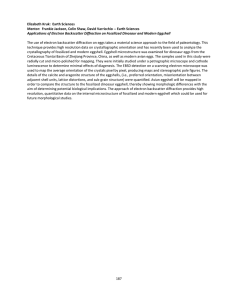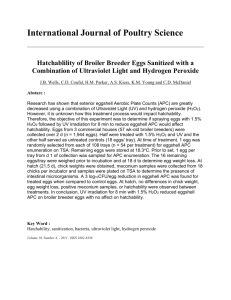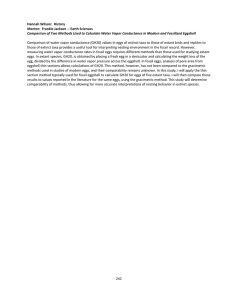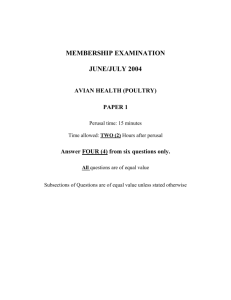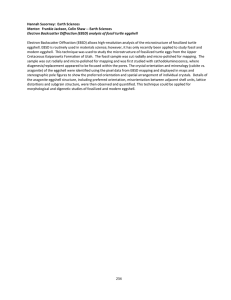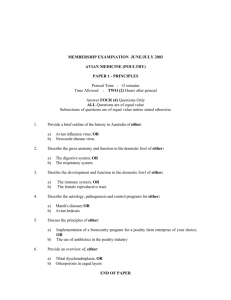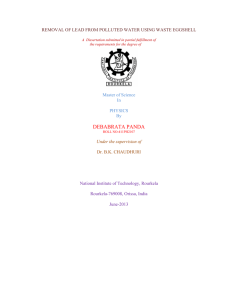2012 UGA Libraries Undergraduate Research Award Chelsea Renier
advertisement
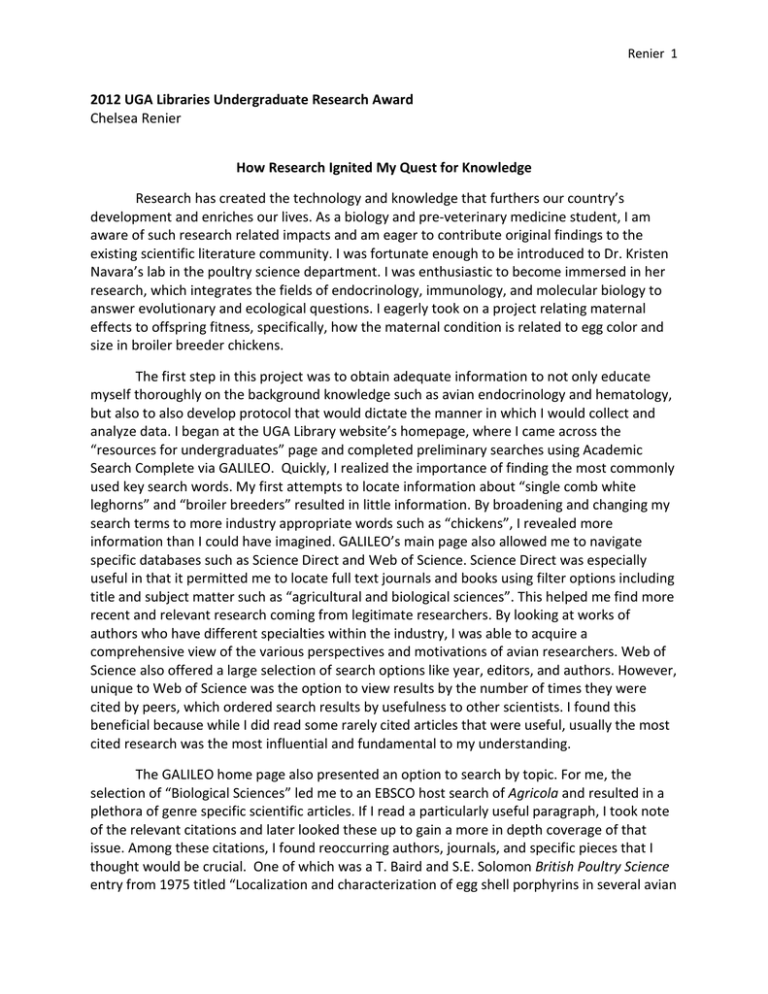
Renier 1 2012 UGA Libraries Undergraduate Research Award Chelsea Renier How Research Ignited My Quest for Knowledge Research has created the technology and knowledge that furthers our country’s development and enriches our lives. As a biology and pre-veterinary medicine student, I am aware of such research related impacts and am eager to contribute original findings to the existing scientific literature community. I was fortunate enough to be introduced to Dr. Kristen Navara’s lab in the poultry science department. I was enthusiastic to become immersed in her research, which integrates the fields of endocrinology, immunology, and molecular biology to answer evolutionary and ecological questions. I eagerly took on a project relating maternal effects to offspring fitness, specifically, how the maternal condition is related to egg color and size in broiler breeder chickens. The first step in this project was to obtain adequate information to not only educate myself thoroughly on the background knowledge such as avian endocrinology and hematology, but also to also develop protocol that would dictate the manner in which I would collect and analyze data. I began at the UGA Library website’s homepage, where I came across the “resources for undergraduates” page and completed preliminary searches using Academic Search Complete via GALILEO. Quickly, I realized the importance of finding the most commonly used key search words. My first attempts to locate information about “single comb white leghorns” and “broiler breeders” resulted in little information. By broadening and changing my search terms to more industry appropriate words such as “chickens”, I revealed more information than I could have imagined. GALILEO’s main page also allowed me to navigate specific databases such as Science Direct and Web of Science. Science Direct was especially useful in that it permitted me to locate full text journals and books using filter options including title and subject matter such as “agricultural and biological sciences”. This helped me find more recent and relevant research coming from legitimate researchers. By looking at works of authors who have different specialties within the industry, I was able to acquire a comprehensive view of the various perspectives and motivations of avian researchers. Web of Science also offered a large selection of search options like year, editors, and authors. However, unique to Web of Science was the option to view results by the number of times they were cited by peers, which ordered search results by usefulness to other scientists. I found this beneficial because while I did read some rarely cited articles that were useful, usually the most cited research was the most influential and fundamental to my understanding. The GALILEO home page also presented an option to search by topic. For me, the selection of “Biological Sciences” led me to an EBSCO host search of Agricola and resulted in a plethora of genre specific scientific articles. If I read a particularly useful paragraph, I took note of the relevant citations and later looked these up to gain a more in depth coverage of that issue. Among these citations, I found reoccurring authors, journals, and specific pieces that I thought would be crucial. One of which was a T. Baird and S.E. Solomon British Poultry Science entry from 1975 titled “Localization and characterization of egg shell porphyrins in several avian Renier 2 species”. With the assistance of UGA librarians and GIL, I was able to select and locate this literature in the UGA Science Library along with the locations of other critical readings. To exhaust all available sources of information, I conducted supplemental research with Google Scholar. This well known search engine was similar to the other resources in that it offered filtration choices such as authors name or initials and peer reviewed journals as possible criteria; however, it was only employed as a supplemental resource due to its excessive extraneous material and its inclusion of works incorrectly deemed scholarly. During my time spent with Google Scholar, I became an expert of the filtration process. I learned the importance of evaluating the legitimacy of all sources carefully. During the course of my literature search, I discovered similar studies to the one I was creating, which analyzed the maternal effects of other avian species including the Eastern Bluebird Sialia siali, Collard Flycatcher Ficedula abicollis, and Lesser Black-Beaked Gull Larus fuscus. I was interested in the methods and results sections of these papers as they gave me insight into specific processes of gathering data and the statistical methods I could likely use to analyze my own results. As I prepared a research proposal for the project, I found the library’s citation style guides, specifically the MLA Handbook, advantageous while I formatted a MLA reference list. In the end I easily accessed more information than was required and I was able to compile my findings into a research proposal. Without the assistance of GALILEO and their specialized databases, GIL, and Google Scholar I would not have been able to further my own academic knowledge and develop my CURO research project. These free resources available to students provide full-text access to published research findings in virtually any field, and prove valuable not only for scientific research but also for furthering students’ educational experiences and academic growth. Among the valuable research skills I learned throughout this literature collection process was the ability to effectively filter through the abundance of information available and balance the extensiveness and relativity of each source. I learned how to maximize my search efficiency and effectiveness, which helped me to obtain the specific genre of information I desired and eliminate distracting and extraneous sources. My literature review process has led me to a deeper understanding of the challenges related to developing a unique research project and the tools I could employ to meet those challenges. I have gained new insight into the importance of scientific literature collaboration and am confident that these skills will be beneficial throughout my educational journey and beyond. I hope to be able to perform more academic research so that I can provide the public with new information that will further the development of the scientific community and hopefully one day, the veterinary medicine community. Renier 3 2012 CURO Abstract AESC 4970H Chelsea Renier Does Eggshell Pigmentation Reflect Female Condition in Broiler Breeder Hens? Brown eggshell pigmentation varies substantially among chicken eggs and is generated by the pro-oxidant protoporphyrin, a metabolite intermediate formed during the biosynthesis of heme. Protoporphyrin can cause oxidative stress damaging cells and tissues, creating reactive oxygen species, and inhibiting antioxidant systems. The hen’s ability to sustain high levels of protoporphyrin in the blood for deposition into eggshells may convey information about female condition. Due to the costs of protoporphyrin generation and deposition, a positive correlation might be expected to exist between female condition and egg color. To test this, six consecutive eggs were collected from each of thirty-one broiler breeder hens and colors were analyzed using a 10 megapixel digital camera and Adobe Photoshop software. During the period of egg collection, the condition of each hen was assessed through weighing, tarsus length measurements, and blood collection for subsequent analysis of circulating levels of corticosterone (a stress hormone), heterophil/lymphocyte ratios (a measure of stress and immunity), and total antioxidant capacity of blood. Condition indices were then related to average measures of hue, saturation, and brightness to determine whether darker egg colors reflect better female condition. We predicted that hens laying darker eggs would weigh more, have lower stress indicators, and a better antioxidant capacity. Results may help determine hen quality in the poultry industry. References Blount, J.D., Surai, P.F., Nager, R.G., Houston, D.C., Møller, A.P., Trewby, M.L., and Kennedy, M.W. (2002) Carotenoids and Eggs Quality in the Lesser Black-Beaked Gull Larus fuscus: A Supplemental Feeding Study of Maternal Effects. Biological Sciences. 269:29-36. Cohen A., Klasing, K., and Ricklefs, R. (2007) Measuring circulating antioxidants in wild birds. Comparative Biochemistry and Physiology, Part B. 147: 110-121. Hargitai, R., Herényi, M., and Török, J. (2007) Eggshell coloration in relation to male ornamentation, female condition and egg quality in the collard flycatcher Ficedula abicollis. 39:413-422. Jakob, E.M., Marshall, S.D., and Uetz, G.W. (1996) Estimating fitness: a comparison of body condition indices. Oikos. 77: 61-67. Kennedy, G.Y., and Vevers, H.G. (1975) A Survey of Avian Eggshell Pigments. Comparative Biochemistry and Physiology, Part B. 55:117-123. Renier 4 Lang, M.R. and Wells, J.W. (1987) A review of eggshell pigmentation. World’s Poultry Science Journal. 43: 238-246. Mikšík, I., Eckhardt, A., Sedláková, P., and Mikulikova, K. (2007) Proteins of Insoluble Matrix of Avian(Gallus Gallus) Eggshell. Connective Tissue Research. 48:1-8. Navara, K.J., Badyaev, A.V., Mendonҫa, M.T., and Hill, G.E. (2006) Yolk Antioxidants Vary with Male Attractiveness and Female Condition in the House Finch (Carpodacus mexicanus). Physiological and Biochemical Zoology. 79:1096-1105. Rubolini, D., Romano, M., Alquati, A.B., and Saino, N. (2006) Early maternal, genetic and environmental components of antioxidant protection, morphology and immunity of yellow-legged gull (Larus michahellis) chicks. European Society for Evolutionary Biology. 19:1571-1584. Shafey, T.M., Al-Batshan, H.A., Ghannam, M.M., and Al-Ayed, M.S. (2005) Effect of intensity of eggshell pigment and illuminated incubation on hatchability of brown eggs. British Poultry Science. 46:190-198. Siefferman, L.,Navara, K.J., and Hill, G.E. (2006) Egg Coloration Is Correlated with Female Condition in Eastern Bluebirds (Sialia Sialis). Behavioral Ecology and Sociobiology. 59:651-656. Soler, J.J., Moreno, J., Avilés, J.M., and Møller, A.P. (2005) Blue and Green Egg-Color Intensity Is Associated with Parental Effort and Mating System in Passerines: Support for the Sexual Selection Hypothesis. Society for the Study of Evolution. 59:636-644. Villafuerte, R., and Negro, J.J. (1998) Digital imaging for colour measaurement in ecological research. Ecology Letters. 1:151-154. Wang, X.T., Zhao, C.J., Li, J.Y., Xu, G.Y., Lian, L.S., Wu, C.X., and Deng, X.M. (2009) Comparison of the total amount of eggshell pigments in Dongxiang brown-shelled eggs and Dongxiang blue-shelled eggs. Poultry Science. 88:1735-1739. Zhao, R., Xu, G.Y., Liu, Z.Z., LI, J.Y, and Yang, N. (2006) A Study on Eggshell Pigmentation: Biliverdin in Blue-Shelled Chickens. Poultry Science. 85:546-549.
